Pacifism
Bertha von Suttner, who in 1905 became the first woman to be awarded the Nobel peace prize, once jested that humanising the war was like regulating the temperature when boiling someone in oil.
However, when war broke out in Europe, it wasn't just pacifists who were shocked, but many erstwhile war enthusiasts too. (For example, the German writer Kurt Tucholsky had signed up for "drunken nationalism" in the first few days of the war. Now he was disenchantedly calling the war 'a worldwide latrine with blood, barbed wire and hate songs".)
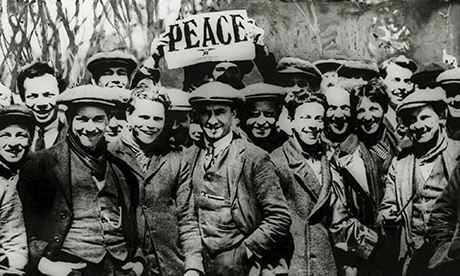
Conscientous objectors at a peace demonstration at Dartmoor, Devon in 1917. Photograph: Bentley Archive/Popperfoto/Getty Images
After the war the pacifists had admittedly more influence than before: about 70,000 members belonged to pacifist groups in Germany, which incidentally was comparatively less than the 500,000 members of the soldiers' unions.
Above all though, the war destroyed a part of their primordial self-certainty. Before 1914, the pacifists had dreamed that wars could be contractually banned – it was an unwordly belief, as was shown. Now the peace-lovers strove for a more realistic, modest aim – disarmament, international understanding, reconciliation and a humanisation of war through the abandonment of certain weapons.
Ronen Steinke, Süddeutsche Zeitung
The Middle East legacy
The first world war and the treaties that followed it redrew the map of the Middle East by creating new states and new political realities on the territory of the defeated Ottoman empire. Rivalry between Britain and France, the growth of Arab nationalism, Zionist ambitions in Palestine and the emergence of modern Turkey all changed the face of the region. It is one of history's neater ironies that lines that were drawn in the wartime sand are starting to blur a century later.
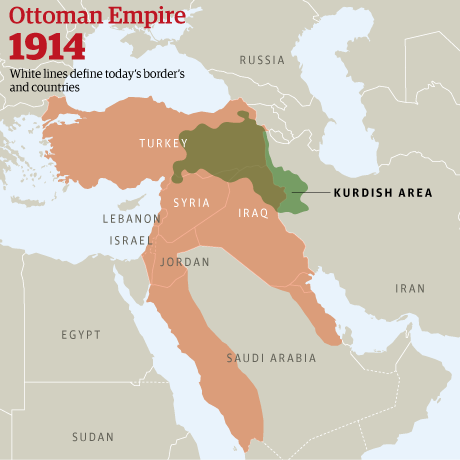
The Sykes-Picot agreement of 1916 secretly divided the former Ottoman lands into British and French zones of influence. The Mandate system created by the interwar League of Nations promised only eventual self-government, not the immediate independence for which Sharif Hussein of Mecca had launched a desert revolt against the Turks – with the help of Colonel TE Lawrence ("of Arabia"). And, in another conflicting pledge, the Balfour Declaration of 1917 gave Britain's support for the creation of a "national home" for the Jews in the holy land – laying the foundations for the emergence of Israel and the world's most intractable contemporary conflict. Historians have been arguing ever since about this tangled diplomacy and its fateful repercussions.
Ethnic, sectarian and tribal differences were of little concern to the colonial-era map-makers. Iraq was formed by merging three Ottoman provinces - dominated respectively by Shias, Sunnis and Kurds. It was also cut off from Kuwait – the genesis of trouble later. Its king was a Hashemite from the Arabian peninsula who had been thrown out of Syria so was the king of neighbouring Jordan, created by a stroke of Winston Churchill's pen after a boozy lunch in Cairo in 1921. Lebanon was split off from "Greater Syria" as a home for the Christians whose support would strengthen French influence.
The biggest losers of the postwar lottery in the Middle East were the Kurds. Nowadays this still stateless people enjoy a high degree of regional autonomy – as well as relative peace – in federal Iraq while their compatriots in Syria control areas that are out of reach of Bashar al-Assad's forces.
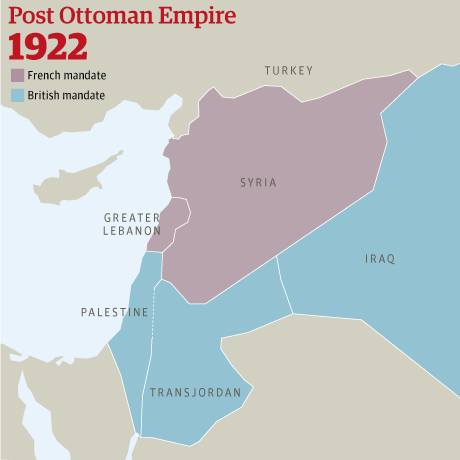
The very idea of Arab nationalism is under threat by sectarian extremists, who look back to Islam to create a new caliphate (abolished by the newly secular Turks in 1922). Assad's enemies include a leading jihadi group with links to al-Qaida. Its Arabic name is "the Islamic State in Iraq and al-Sham (Syria and Lebanon)" – a deliberate erasure of those post-first world war frontiers.
Ian Black, the Guardian
Filmed propaganda
In a conversation with the philosopher Alexander Bogdanov in 1907, Lenin spoke of cinema as "one of the most important means of education of the masses". The first world war was to prove him emphatically right.
At the start of the war, audiences – and governments – were still relatively new to the idea of cinema. But in the US alone, 2,500 films were produced between 1915 and 1918. Many such as Zepped contained an undeniable propaganda slant to them. Others were produced to more subtle effect, such as The Battle of the Somme – a British effort to appeal to US public opinion and draw America into the war. In Italy, Maciste alpino, by Luigi Romano Borgnetto and Luigi Maggi (1916) emphasises the values of battle, pushing the audience to identify with the hero protagonist.
But not all of it was pro-war. In Civilization (1916), Thomas Harper Ince launched his allegorical cry for peace. Abel Gance's J'accuse, with some scenes filmed on real battlefields, is undeniably pacifist.
But the jewel of the period, dated 1918, is the Charlie Chaplin film Shoulder Arms, which illustrates, halfway between tragedy and farce, the horrors of life at the front.
Fulvia Caprara, La Stampa
Workers of the world
For the European socialist and labour movement , and the nascent trade union movement , the outbreak of the first world war was a terrible shock. Though well organised in countries including Germany, Britain and France, the leadership of socialist and social democrat parties failed to mobilise against the war in the summer of 1914.
The parties and the first trade unions (with the exception of Italy, which maintained its neutrality until May 1915) were co-opted into the war effort and production. For a long time workers in large industries – in particular skilled workers, crucial for the production of machinery and armaments necessary to feed the monstrous battle of materials at the front – were not only exempted from recruitment into the army, but also enjoyed favourable food and wage conditions in return for the banning of strike action.
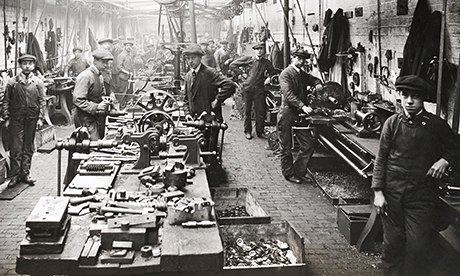
A first world war ammunition factory in Wolverhampton. Photograph: Popperfoto/Getty Images
But as the war destroyed lives and resources, living and working conditions for factory workers gradually declined. Socialist minorities began to agitate for a peaceful settlement of the conflict; the Russian year of revolution in 1917 turned the political calculus upside down, reviving radical political parties and trade unions in all the belligerent countries. One of the few things left standing at the end of the war in 1918 was an aggressive, organised, determined European trade union movement about to embark on its heyday.
Roberto Giovannini, La Stampa
The planned economy
Before the Soviet Union forced a planned economy on half of Europe, the Germans had discovered it. The first legislation limiting economic freedom was implemented on 3 August 1914.
The German state took control over citizens' savings, foreign trade and the production and sale of food. It also set maximum prices for various goods and introduced "raw material associations", which controlled the distribution of raw materials that were in shortage according to the needs of a war economy.
In November 1916, a planning institute was established and the total mobilisation of resources and labour was implemented. Industry was organised into 170 "war associations" based on previous chambers of industry. The programme halted what had amounted to a decline in production for the army, although consumption and agriculture continued to face a slump.
The prices of basic products rose eightfold during the war and millions of Germans were forced into starvation – food rations amounted to 700-900 calories daily. At the time, others considered the military mobilisation of the Germans a huge achievement.
It made a huge impression on the Bolsheviks, who were then waiting to take over power in Russia. When Lenin took control in 1918, he introduced "war communism" – an economy based on nationalisation and the robbery of assets.
It gave the Bolsheviks control over economic life and the resources necessary to win the civil war but it also brought with it a downturn in living standards, widespread poverty and the destruction of production capacity.
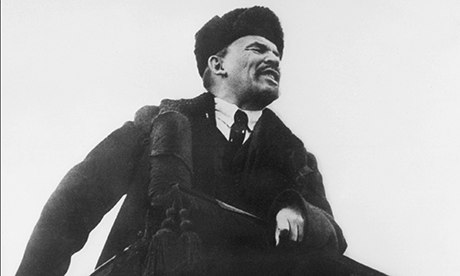
Lenin introduced 'war communism' to the Russian economy in 1918 following the Bolshevik revolution and Russia's exit from the war. Photograph: AFP/Getty Images
At the beginning of the 1920s, the communists in Russia announced NEP – "New Economic Policy" – making a compromise with the market by leaving it with a large chunk of the production of consumption goods. The planned economy was to the taste of politicians as well as journalists with various political views.
In the period between the two great wars, during which people were shaken by hyperinflation and the Great Crisis, capitalism was commonly viewed as something that meant chaos and the ineffective allocation of creative energy.
Both the radical left and the radical right believed that capitalism created wealth among the few and poverty among the masses and that a planned economy helped to even out income and led to greater solidarity in society.
After the Great Crisis, experiments were carried out with various forms of a planned economy not only in Germany or the Soviet Union but in many European countries, including Poland.
Adam Leszczyński, Gazeta Wyborcza
Nation states
The year 1918 radically reshaped the map of central and eastern Europe. Several new states (or ones recreated after a century) appeared in the place of three powerful empires – Germany, Russia and Austria-Hungary.
The new countries were poor, in conflict with each other and studiously divided by borders and customs duties. It was the era of triumphant nationalism. Countries such as Ukraine suffered the bad luck of having been unable to successfully fight for their own state because their rivals had proven stronger.
n September 1918, the Austro-Hungarian empire tried to make contact with western powers to ask for a ceasefire. The US, by then the most powerful country in the world and one untouched by the war, replied that its stance had been presented by President Woodrow Wilson in January of that year in his Fourteen Points proposal.
Apart from his postulates of transparent international agreements, unfettered access to the seas and the lifting of trade barriers, Wilson had talked about new borders in Europe based on ethnicity and had also mentioned the rebirth of Poland. As it would later turn out at the Versailles conference in 1919, his postulate of "borders based on ethnicity" would prove to be not only utopian, but also the precursor to many conflicts.
In central Europe, nations often lived side by side with each other and claimed ownership of the same territories. Each resolution passed by the big powers triggered diplomatic protests and, quite often, armed conflict.
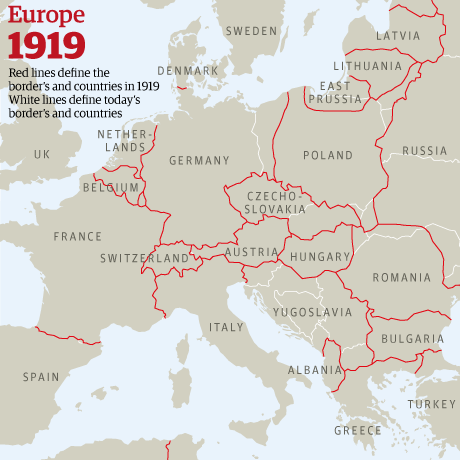
The biggest of the new countries was Poland, which had disappeared from the map for 123 years after being partitioned in 1795. Its territory was reclaimed thanks to armed conflicts with the Germans, Ukrainians, Lithuania, Czechoslovakia and the great battle with Russia. In 1923 when its borders were finally settled, Poland had relatively good relations with only two neighbours – tiny Latvia to the north and a distant Romania to the south. This would soon prove fatal.
And yet the war also produced the League of Nations – the world's first proper attempt at an international peace-keeping organisation. Its successes and existence were shortlived, and it would take another world war for the second iteration, the United Nations, to be born.
Adam Leszczyński, Gazeta Wyborcza
The "broken faces"
Modern surgery was born in the first world war, where civil and military hospitals acted as theatres of experimental medical intervention. Trench warfare meant that the head and the face were especially exposed to enemy fire. Countless veterans survived the war but paid the price by leaving it maimed, mutilated and disfigured. These were the so-called "broken faces", named after an expression coined in France by colonel Yves Picot, president of the Union des blessés de la face et de la tête, which was founded in 1921.
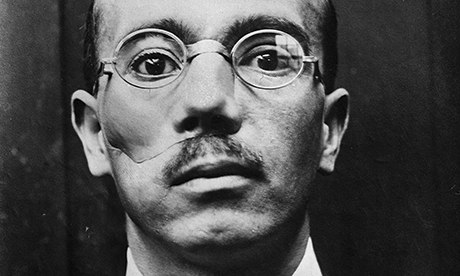
A man who underwent reconstructive facial surgery after being wounded in the first world war. Photograph: Boyer/Roger Viollet/Getty Images
By the end of the first world war there were about 6.5 million war invalids in France. Surgeons from the belligerent countries faced a considerable flood of these "broken faces", and were charged with giving them human features again, to ease the plight of their reintegration into civil life. Missing flesh and bone were covered up with graft, an innovation that came about by using skin from other parts of the body.
Paul Benkimoun, Le Monde
Blood banks
The discovery in 1914 that blood could be prevented from clotting if mixed with sodium citrate, plus the benefits of refrigeration, were huge breakthroughs that paved the way for blood banking.
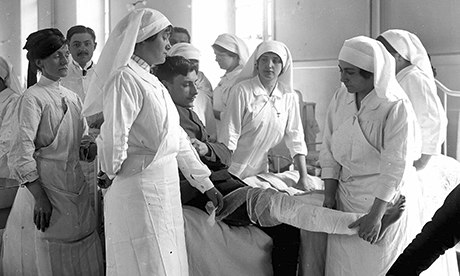
Nurses tending to wounded soldiers in France, 1915. Photograph: Branger/Roger Viollet/Getty Images
In the second half of the war, medics improvised to use preserved blood at casualty clearing stations, though initial survival rates were not good. Finding donors was not a problem, but overlooking blood groups was. Still, the sudden advances led to a blood donor service being established in London in 1922.
Mark Rice-Oxley, the Guardian
The decline of aristocracy
Those sons of the British upper classes fortunate enough to survive the first world war returned to find a country in a state of flux and their place in it no longer automatically assured.
Their diminished numbers – until late 1917, the upper classes suffered proportionately greater losses in the fighting than any other class – ensured that a resumption of the prewar status quo was physically impossible.
"The apprentices for the postwar were no longer there; they were lying in Flanders Fields," says Joanna Bourke, professor of history at Birkbeck College, London.
"This had a devastating impact: the prime minister's son was killed, a number of cabinet members' sons were killed and this meant that in the immediate postwar, those apprentices who were expected in the natural order of things to become leaders – particularly in politics and business – were no longer there."
But not only were the numbers of the male upper classes severely diminished; there was also a fall in the number of those willing to serve them and their families as they had done for hundreds of years.
Many of the women whom the war effort had forced out of domestic service and into factories found themselves unwilling to relinquish their new independence.
"You get the delegitimisation of the whole structure that maintains upper middle-class life," says Bourke.
"In the past, the servant class in upper middle-class homes were those people whose family tradition was to work there. When someone left, the cook would recommend her niece – and that no longer happened, so there's a real crisis in terms of the labour that's required to keep up these lifestyles."
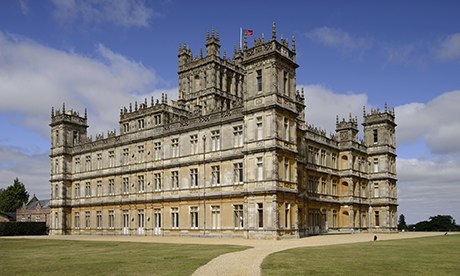
The first world war had a devastating impact on the British upper classes, which meant a resumption of the prewar status quo was physically impossible after the armistice. Photograph: Jonathan Hordle/Rex
The decline of the upper classes was further hastened by the passing of the Representation of the People's Act in June 1917, which gave the vote to an additional 5 million men and nearly 9 million women.
The extension of the franchise, coupled with an explosion in trade unionism, afforded the working classes greater social representation and with it the freedom to challenge the power of the establishment parties and question the wisdom of those who had sent so many soldiers to their deaths.
But perhaps the greatest harbinger of the decline of the upper classes emerged from the mud and blood of the western front as the institution charged with protecting the traditional British way of life became the unwitting agent of its dissolution.
The introduction of conscription in 1916 turned a professional army into a civilian one and flooded its ranks with middle-class men whose mothers and fathers occupied powerful places in society and used those positions to demand that their children's sacrifices were not in vain. It also led to the rise of new officers from humble backgrounds who, like so many thousands of female Britons at home, were not prepared to abandon the possibility for social advancement that the war had brought them.
As Bourke puts it: "These people came back – some of them with medals – and they weren't going to go back to being shopkeepers."
Sam Jones, the Guardian
Christian democracy
The catastrophic heights that the first world war provoked drove French politicians and intellectuals to protest "never again".
Marc Sangnier, founder of the Sillon movement at the end of the 19th century, was one of the figures emerging from that rallying cry. This thread of social Christianity extolled a reconciliation of the church and the republic in the name of a third way between capitalism and socialism.
Like his contemporary Jean Jaurès, Sangnier became the sworn enemy of the Catholic monarchists led by Charles Maurras. Sangnier served as a trench engineer during the war. In 1916, the joint prime minister and foreign minister, Aristide Briand, made Sangnier an ultimately unsuccessful peace emissary between the pope and France. Sangnier left the war as a commander and was decorated with the legion of honour and the French Croix de guerre.
From 1919 to 1924, Sangnier was a statesman. His colleagues were sarcastic about his efforts to restore Europe through international collaborations with the likes of Russia and Germany. Only the left and the extreme left applauded this curious Christian for radical pacifism, a visionary who was elected with the moderate right but who the conservatives classified as a "bolshevik Christian". His idea was to organise the "peace for youth" through international democracy. This led to international congresses; the grand finale in Bierville in August 1926 featured more than 5,000 participants from 33 nations, although the majority were Germans.
When Sangnier died in 1950, the ideas he defended lived on in the Christian Democrats who held power in France, Germany and Italy.
Michel Lefèbvre, Le Monde
Women's emancipation
Historians still wrangle over whether the war liberated women. Without a doubt, women accomplished a high number of largely masculine roles during the war. Without a doubt, women achieved the most important political rights in certain countries (such as Britain). Without a doubt, some of the fashions, such as the flapper "garçonne" ("little boy") look, evoked an emancipation of the traditional feminine codes. However, in reality women's work was already on the rise before 1914 and once the war was over, many women went back to their old jobs.
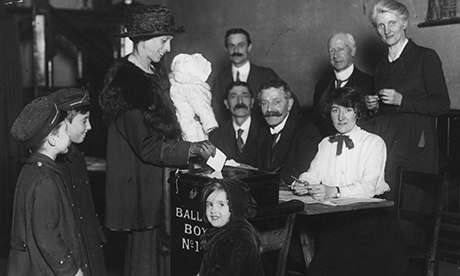
An newly enfranchised woman votes in December 1918. Photograph: Topical Press Agency/Getty Images
The feminisation of work is limited and depends on what sector it is in. It grows in business, in liberal professions or in banks. In fact, women are denied quite a few rights (in France, women only won the right to vote in 1944. In Germany they could vote as of 1919, in Great Britain from the age of 30 in 1918, and from the age of 21, like men, in 1928). Often the forms of emancipation of traditional roles were socially and quantatively restrictive. Recent works suggest that this period was a transitional phase, a teaser of the evolutions to come.
Nicolas Offenstadt, Le Monde
• This article was amended on 16 January 2014. The earlier version referred to sodium nitrate where sodium citrate was meant.
http://www.theguardian.com/world/2014/jan/15/firstworldwar
